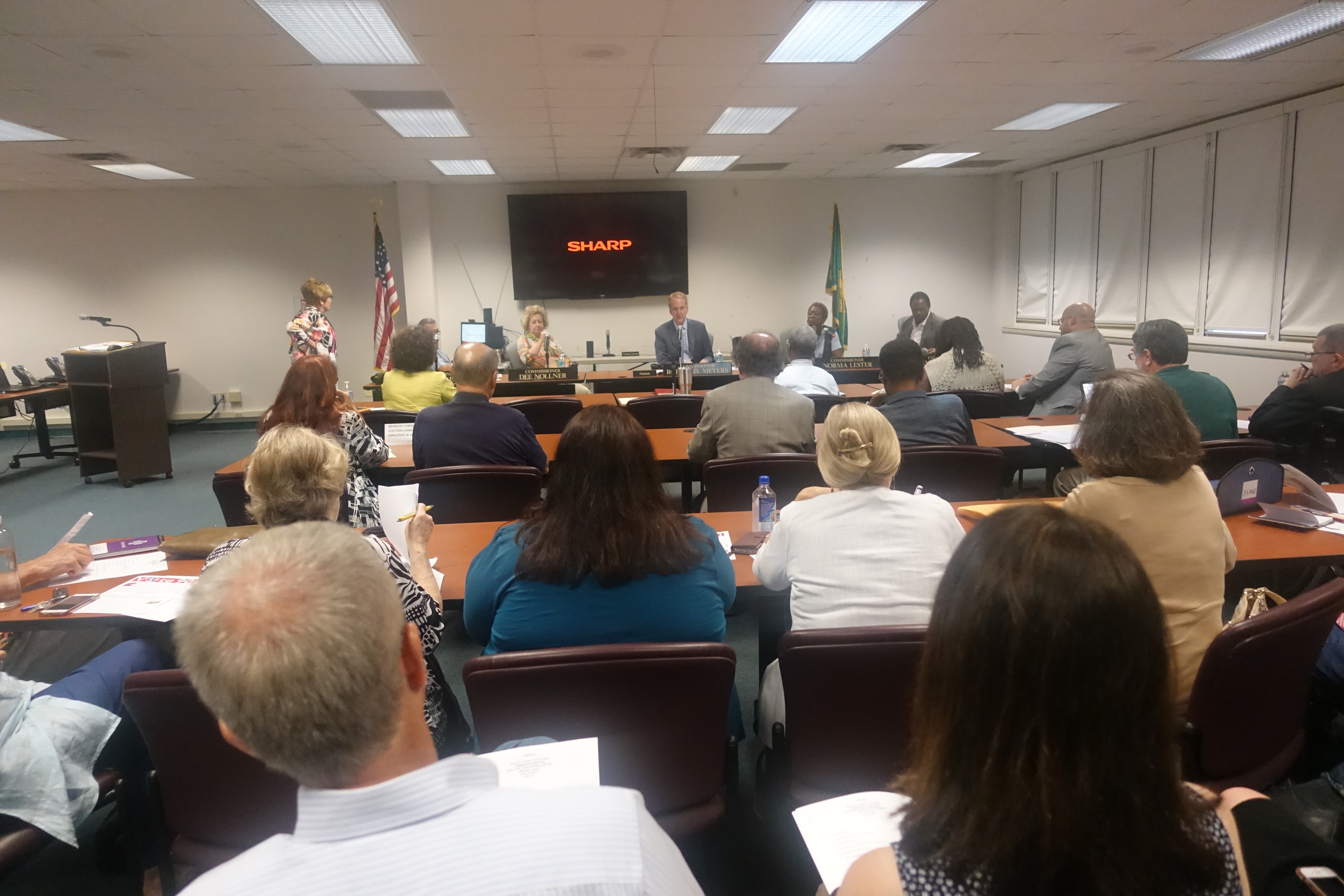 JB
JB
Election Administrator Linda Phillips at last week’s briefing on Ranked Choice Voting
“Ranked Choice Voting,” aka “Instant Runoff Voting,” is coming to Memphis in time for the city election of 2019. So says Shelby County Elections Administrator Linda Phillips, who conducted a public briefing on the process last Wednesday at the Election Commission’s Nixon Drive headquarters in Shelby Farms.
A sizeable turnout gathered to hear Phillips explain the process by which voters can rank their choices 1-2-3 in a given race on the ballot, after which a process of redistributing vote totals will allow for a majority winner to be selected in a multi-candidate race in which the initial leader holds only a plurality.
In theory, the process works simply and with mathematical precision — though it could take days in some cases to sift through the numbers and announce a winner.
In practice, the process can sound quite complicated, as, at times, it did last week during Phillips’ methodical elaboration of mathematical possibilities in a hypothetical race involving “candidates” named after the planets in our solar system. (“Pluto” would have won by plurality, but succumbed to “Venus” when all the ranked choices were considered.)
But the complexity of the process is deceptive, in the same sense in which a computer’s “search” mechanism, simple in its basic functioning, can be made to sound abstruse and even threatening.
Here’s an explanation of one variant of the process from University of Memphis law professor and former County Commissioner Steve Mulroy, an early advocate, from a Flyer Viewpoint by him in 2008:
“In IRV, voters rank candidates in preference order: “1,” “2,” “3,” etc. Voters can rank as many or as few candidates as they wish. If a candidate gets a majority of first–place votes, that candidate wins. If not, the candidate with the fewest first-place votes is eliminated. Votes for that candidate are redistributed among the remaining candidates based on those voters’ second-place choice. If someone thereby gains a majority, they are elected. If not, the next-weakest candidate is eliminated and the vote redistributed, until someone gets a majority.”
Or, as Mulroy put it at Wednesday’s meeting, “All the voter has to understand when he walks into the voting booth, is first choice, second choice, third choice.” Just as all a Google searcher has to do is put a name or a phrase in a blank and then click with his mouse.
T JB
JB
There was a packed house at the Election Commission’s Nixon Drive headquarters.
o avoid confusion, the Election Commission plans to employ “lots of voter education” on how R.C.V. works.
The Election Commission, as Phillips explained, will try out the Ranked Choice Voting method this fall via an “in-house” mock election, involving Commission staff members only — although the media will be invited to observe that first experiment. A second mock election, involving the public, will be held at some unspecified point after the first one.
In any case, the Ranked Choice Voting formula will, as indicated, be applied for real in the city election of 2019. As with the two mock elections, the first round of voting will be automatically compiled on the currently available machines, but subsequent rounds of redistributing and counting votes will be done manually, accounting for the aforementioned delay in announcing results.
That delay would necessitate some additional costs, Phillips conceded, but not to the extent of the mandatory — and skimpily attended — runoff elections held in city districts where no candidate gets a majority in the first round.
Administrator Phillips also conjectures that the city’s two at-large Super Districts might be eligible for R.C.V. in 2019, although they have not been subject to runoffs since a 1991 ruling by the late U.S. District Judge Jerome Turner was regarded as precluding such a prospect. Presumably, the Ranked Choice Voting process is different enough in its implications (it leaves no opportunity for a runoff-round “bias shift,” for example) to warrant a reconsideration.)
That it will have taken more than a decade since voters, in essence, approved an R.C.V.-like process via a charter amendment in 2008, is due to a combination of circumstances: confusion at the Election Commission as to whether it would need to purchase specific kinds of sophisticated equipment; and similar confusion and/or reluctance at the level of state government, which has the duty of certifying local voting systems.
Whatever the facts were then, Phillips pr
 JB
JB
Voting-machine watchdog Dr. Joe Weinberg expressed a desire for ‘paper trail’ voting.
ofesses certainty that the touch-screen voting machines currently in use in Shelby County can accommodate the Ranking Choice Voting method.
The desirability, as soon as possible, of machines with “paper-trail” capability was voiced by some attendees at Wednesday’s briefing session — notably RCV supporter Dr. Joe Weinberg, a veteran watchdog on what he sees as a susceptibility to hacking on the part of the voting technology currently in use.
Phillips has asserted, and did so again on Wednesday, that the Commission intends to purchase new machines in 2020 or 2021 for use in the 2022 election cycle, although whether these machines will be equipped to provide reliable “paper-trail” results — a feature sought by Mulroy, Weinberg, and other advocates of voting-machine reform — will remain unknown until the funding and acquisition process is completed.
A spokesperson for Phillips said this week that the Commission has $2 million in leftover HAVA (Help America Vote Act) funds and will attempt to secure another $11.7 million from county, state, or federal sources to complete the purchase.